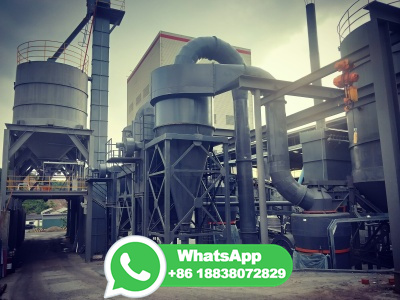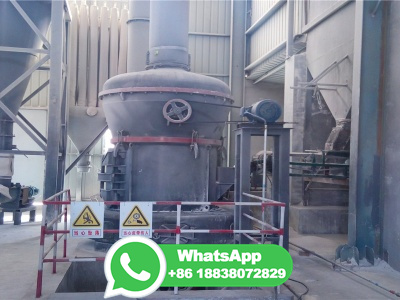
WEBThe second step in coke production is to process the raw material, coal, into a consistency appropriate for coke oven achieve this consistency, coal is pulverized in a crusher and, if necessary, mixed with water and oil to control the density of the pulverized coal mixture. A basic diagram of the most common coke making process.
WhatsApp: +86 18203695377
WEBSinter plants agglomerate iron ore fines (dust) with other fine materials at high temperature, to create a product that can be used in a blast final product, a sinter, is a small, irregular nodule of iron mixed with small amounts of other minerals. The process, called sintering, causes the constituent materials to fuse to make a single porous mass with .
WhatsApp: +86 18203695377
WEBSep 1, 2020 · So far, however, the steelmaking process has withstood engineers' best efforts to clean it up: there are simply too few lowcost replacements of key inputs such as coking coal and coke.
WhatsApp: +86 18203695377
WEBJul 7, 2022 · By using green hydrogen instead of coal, we can reduce CO2 emissions from the reduction process with around 95 percent. So, how does it all work? In traditional steel making, reduction of iron ore is done by heating it together with coal, utilizing a chemical reaction that separates the oxygen from the iron, forming and emitting CO2.
WhatsApp: +86 18203695377
WEBNov 1, 2021 · The steel industry is considered the most important basic industry and is crucial role for strengthening the national economy; however, its high energy intensity and carbon emissions render it a ...
WhatsApp: +86 18203695377
WEBMar 4, 2021 · The steel industry accounts for 4% of all the CO2 emissions in Europe and 22% of the industrial carbon emissions in Europe. Several options for its decarbonization are possible: increasing the efficiency of current production methods, recycling of steel, carbon capture and storage (CCS) and hydrogen. Hydrogen as a solution to .
WhatsApp: +86 18203695377
WEBFig. 3 shows a flow sheet of the SL/RN process. Sized lump iron ore (or pellets) and a relatively coarse fraction of noncoking coal are fed into the kiln from the feed end. Coal not only acts as a ...
WhatsApp: +86 18203695377
WEBNov 4, 2018 · Pulverized coal has basically two roles in the operation of a BF. It not only provides part of the heat required for reducing the iron ore, but also some of the reducing gases. ... It can also help remove S released from the coke and coal. Process issues. ... Steel production is a water intensive process, consuming around 180 cum to 200 cum .
WhatsApp: +86 18203695377
WEBDec 20, 2021 · High energy intensity, large volume of production, and high dependence on coal as the major energy source are the most prominent features of the steel industry, and the energy demand and CO 2 emissions ( Gt/y) of the steel industry reportedly account for approximately 8 and 7% of the global value, respectively (International Energy .
WhatsApp: +86 18203695377
WEBApr 21, 2021 · From a technical perspective, the challenge of decarbonization involves two processes: chemical reduction for iron ore refining (process emission), commonly with metallurgical coal and coke, and from the hightemperature heat sourced needed to operate blast furnace (BF) and other production reactor. 5 Unlike the power sector, there are .
WhatsApp: +86 18203695377
WEBFeb 3, 2022 · Supported by cleaner production, the global steel market is forecast to grow by 557 million tonnes during, progressing at a compound annual growth rate (CAGR) of %. As demand for ...
WhatsApp: +86 18203695377
WEBOct 29, 2018 · The global coal market is greatly affected by the development of the steel industry and the availability of coal resources in China and India and also by developments in some other new coalconsuming countries. New steelmaking capacity has appeared in South East Asia: in particular, blast furnaces and coke plants in Vietnam and Indonesia.
WhatsApp: +86 18203695377
WEBAug 22, 2021 · play essential roles in this steel making process. Lime. ... The experimental results show that carbon black is the least reactive followed by thermal coal and charcoal. It was found that the ...
WhatsApp: +86 18203695377
WEB3 May 2022 10 min read. More than ninety per cent of Australia's current iron ore exports are mined from the deep red weathered Pilbara landscape in Western Australia and over 70 per cent of this material is shipped to China, where it is made into iron in blast furnaces using coke manufactured from coal, then further processed into steel.. Australia mines .
WhatsApp: +86 18203695377
WEBBasic oxygen steelmaking ( BOS, BOP, BOF, or OSM ), also known as LinzDonawitz steelmaking or the oxygen converter process, [1] is a method of primary steelmaking in which carbonrich molten pig iron is made into steel. Blowing oxygen through molten pig iron lowers the carbon content of the alloy and changes it into lowcarbon steel.
WhatsApp: +86 18203695377
WEBPhosphorus removal: Phosphorus, contained in the iron ore and the scrap metal that are used to start the steelmaking process, can seriously damage the properties of large quantities, it lowers the ductility of the steel making it easy to fracture when it is coldworked. Quicklime added to the metalmaking process extracts the phosphorus in the .
WhatsApp: +86 18203695377
WEBTechnology. Steel is an alloy composed of between and percent carbon, with the balance being iron. From prehistory through the creation of the blast furnace, iron was produced from iron ore as wrought iron, –100 percent Fe, and the process of making steel involved adding carbon to iron, usually in a serendipitous manner, in the forge, or .
WhatsApp: +86 18203695377
WEBJul 18, 2023 · The Bessemer process was a steelmaking method developed by Sir Henry Bessemer in the 1850s that revolutionized the production of steel. The method involved steelmakers heating pig iron in a furnace to reach a specific temperature. Once the burning iron became molten, it was transferred to the Bessemer converter, which was like a fiery ...
WhatsApp: +86 18203695377
WEBSep 25, 2020 · The 1850s and 1860s saw the advent of different revolutionary techniques, turned the steelmaking process into a mainstream industry. The ensuing technological advancements in the injection technology as well as in the process control, has made mass production of steel easier, and an integral part of the global economy. ... coal and .
WhatsApp: +86 18203695377
WEBFeb 14, 2023 · The steel industry is one of the major sources of greenhouse gas emissions with significant energy demand. Currently, 73% of the world's steel is manufactured through the coalcokebased blast furnacebasic oxygen furnace route (BFBOF), emitting about two tonnes of CO 2 per tonne of steel produced. This review reports the major .
WhatsApp: +86 18203695377
WEBCoke making is effectively the carbonization of coal at high temperatures. Production normally takes place in a coke battery loed near an integrated steel mill. In the battery, coke ovens are stacked in rows. Coal is loaded into the ovens and then heated in the absence of oxygen up to temperatures around 1,100 degrees Celsius (2,000 degrees ...
WhatsApp: +86 18203695377
WEBIn 2022, coal accounted for about % of electricity generation. Coal use by industry. Many industries use coal and coal byproducts. The concrete and paper industries burn large amounts of coal to produce heat. The steel industry uses coal indirectly as coal coke to smelt iron ore into iron to make steel. The high temperatures created by ...
WhatsApp: +86 18203695377
WEBJun 10, 2020 · Iron is extracted in the form of metallic iron (Fe) by reducing the oxide ores with a reducing agent. The principal agents commonly employed to serve this reduction process are the naturally occurring forms of carbon such as coke, charcoal and coal. In order to extract the iron, Fe (55–60%)rich ore is usually used.
WhatsApp: +86 18203695377
WEBApr 23, 2024 · Blast furnace, a vertical shaft furnace that produces liquid metals by the reaction of a flow of air introduced under pressure into the bottom of the furnace with a mixture of metallic ore, coke, and flux fed into the top. Blast furnaces are used to produce pig iron from iron ore for subsequent processing into steel.
WhatsApp: +86 18203695377
WEBFeb 14, 2017 · From an emasculated industrial base that left the Soviets underproducing Germans in coal and steel by a ratio of one to four, Soviet factories turned the tables, outproducing Germany nearly three to one in tanks during the vital 1942–1943 period. ... A national bias against mass manufacturing certainly played a role. But the Germans also ...
WhatsApp: +86 18203695377
WEBJun 21, 2023 · Coal is primarily used as a fuel to generate electricity and in Australia is used to produce about 80% of the nation's electricity requirements. A special type of coal used to produce coke for the steel making process and byproducts of cokemaking include coal tar, ammonia, lights oils and coal gas.
WhatsApp: +86 18203695377
WEBMay 29, 2013 · Very pure steel was produced as an unintentional byproduct of the process, without any CO2 generation. Conventional steelmaking route involves heating iron oxide in a furnace along with coke at temperatures ranging from 900°C to 1,300°C and producing hot metal with impurities such as carbon and trace amounts of sulphur, and .
WhatsApp: +86 18203695377
WEBBessemer converter, schematic diagram. The Bessemer process was the first inexpensive industrial process for the mass production of steel from molten pig iron before the development of the open hearth key principle is removal of impurities from the iron by oxidation with air being blown through the molten iron. The oxidation also raises .
WhatsApp: +86 18203695377
WEBApr 29, 2023 · Steelmaking is a. crucial industrial process that plays a vital role in the development of modern societies. Steel, with its e xceptional. strength, vers atility, and durability, has become an ...
WhatsApp: +86 18203695377
WEBApr 15, 2021 · 1. Introduction. The iron and steel industry (ISI), one of the hardtoabate sectors, is responsible for 7% of anthropogenic CO 2 emissions on a global scale. The Blast Furnace – Basic Oxygen Furnace (BFBOF) process dominates global steel production and requires coalbased coke as the main reducing agent in the chemical conversion of .
WhatsApp: +86 18203695377